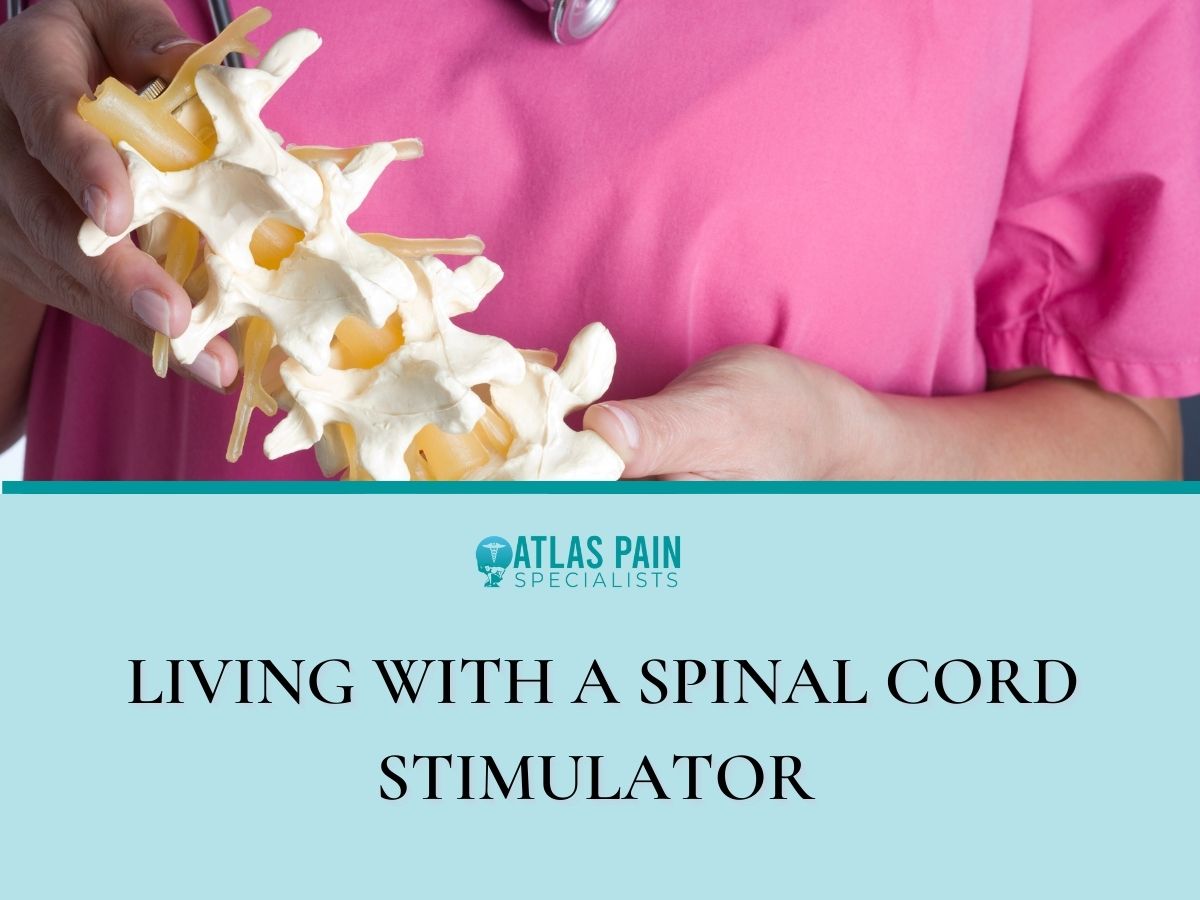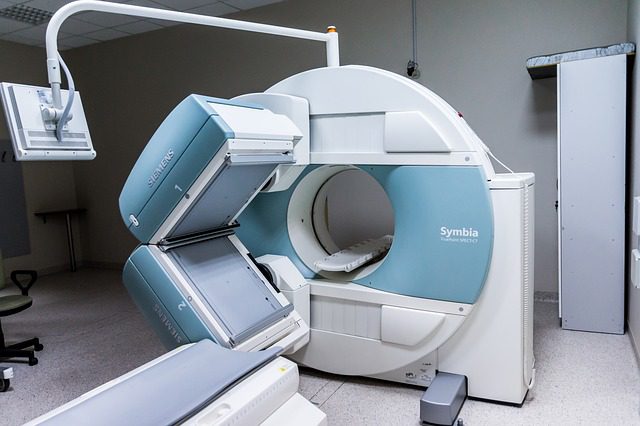

Living With A Spinal Cord Stimulator
If your persistent pain isn't responding to over-the-counter or prescription drugs, you should consider a spinal cord stimulator (SCS) as an alternative. This makes you curious about what your life will be like after the gadget is implanted, but we are here for that in summary.
Each year, over 60,000 spinal cord stimulators are implanted. If you're one of the 60,000 people who suffer from severe back pain, then you've been there. To put it another way, you're aware of how tough it may be to carry out everyday tasks that most people take for granted.
Living with a spinal cord stimulator, on the other hand, requires you to be more aware of your surroundings, but you don't have to give up all of your liberties to use one. To help you get the most out of your spinal cord stimulator, our team at Atlas Pain Specialists is here to guide you every step of the way. We'll also provide information on how to maintain a pain-free lifestyle after your procedure.
An overview of spinal cord stimulators
Your back discomfort may be alleviated with the help of a spinal cord stimulator. Wire placement in your spine is less invasive and may be done with minimum scarring.
Pain signals coming from your spine to your brain are disrupted by the wire's modest electrical currents. Sciatica and nerve damage that causes severe back pain benefit most from this treatment.
You begin with a trial run of your stimulator in your back. Batteries will stay outside of your body throughout this trial period to allow us to make sure the stimulator is working properly for you.
Once your symptoms begin to improve, you enter the "permanent" phase of treatment. The generator pack is then implanted in your lower back or upper buttock by our specialists. The stimulator may be turned on and off using a remote control provided to you.
Physical therapy and other strength-building methods may be able to help you recover from your back injury now that your stimulator is in place.
Is SCS a good fit for me?

Stimulators for the spinal cord are not appropriate for all types or degrees of pain. Patients who are interested in spinal cord stimulators often have already tried a variety of other therapies that have failed.
Most individuals don't utilize spinal cord stimulation as their primary method of treating chronic pain since it is a two-stage surgical procedure. Physical therapy, activity modification, and chiropractic care are common first-line treatments for pain.
A spinal cord stimulator may be recommended by your doctor if those and other less invasive therapies fail.
The first step in a more interventional approach is to have a trial stimulator inserted if it becomes evident that you require it. Talk to your doctor about a more permanent implant if this improves your pain after a specified amount of time.
Spinal cord stimulation is used to treat a variety of disorders, the most frequent of which are:
- Pain in the lower back.
- A condition is known as failed back surgery syndrome
- Membrane inflammation affecting the brain and spine (arachnoiditis)
- Angina
- Accidents resulting in damage to the spinal cord
- Inflammation of the nerves (e.g., diabetic neuropathy and cancer-related neuropathy from radiation, surgery, or chemotherapy)
- Vascular disease of the extremities
- Myalgic encephalomyelitis
- Amputation-related discomfort
- Pain in the abdomen and the perineum
A spinal cord stimulator may not be right for you even if you've tried other therapies and found no relief.
You can't use your spinal cord stimulator because you're pregnant or because your spinal cord stimulator trial didn't reduce your discomfort. Surgical complications are a real possibility for you.
Each patient's experience with pain is completely unique to that individual. Talk to your doctor about all of your treatment choices to see whether spinal cord stimulation is right for you. You may rely on them to provide FDA-approved gadgets for your particular pain problem since they are familiar with your treatment history.
Issues you may encounter living with a spinal cord stimulator
Magnetic fields
You are surrounded by magnetic fields at all times. Everywhere you go, you're likely to come into contact with magnetic fields at some time throughout the day. If you come into contact with a magnetic field, there are techniques to keep your stimulator from being disrupted.
Imaging

Even if you have a spinal cord stimulator put in your back, you may still need an MRI or X-ray. If you contact our doctors and the imaging professionals in charge early, you may have these tests done securely.
To ensure that your stimulator can endure an MRI or X-ray, you need to know what sort of stimulator you have. To ensure your safety and the safety of the stimulator, you should switch it off while the operation is being performed.
Airport and other security measures
Detection devices employ magnetic fields to search for undesired things. Ask for permission to entirely bypass the device. Go through it as soon as possible without using your stimulator, if at all possible.
Other gadgets
No matter how hard you try, magnetic fields will always be there. Being aware of your surroundings is the finest thing you can do. Do not go too close to electricity lines, generators, or huge magnetic stereo speakers. Keep a safe distance from tag deactivators and other anti-theft equipment while shopping or using a library, for example.
Mobile devices like smartphones and tablets are secure to use, but be wary of credit cards and other financial instruments. It's possible that the stimulator's magnets will interfere with the magnetic strip on the cards.
Water contact
Patients with a stimulator are concerned about swimming and bathing. The good news is that if you have a permanent stimulator, you may leap into the pool, lake, or ocean and completely immerse yourself in water. It is impossible for a trial stimulator to get moist, particularly when using new sutures.
Driving
Your simulator is not safe to use while driving or operating heavy equipment. While driving, use your remote control to turn off your stimulator. You're permitted to use your stimulator while driving in the backseat.
Traveling
Flight attendants and other air transport workers may ask you to switch off your stimulator. Taking off and landing might be hindered by it. Before you board, make sure you have your remote in hand and speak with the flight crew.
FAQs
How do I operate my spinal cord stimulator?
In addition to controlling the frequency and strength of electrical impulses, your spinal cord stimulator settings regulate the region in which the impulses are delivered. With a portable controller, you may adjust the initial pulse setting as required.
You may also be able to set various degrees of stimulation at different times of the day. A nighttime mode is available if you want a lower level of brightness.
No matter where you go or what you do, make sure you always have your controller close by so you can get the correct amount of relief.
As part of your doctor's instruction, he or she will demonstrate the device's unique programming processes and ensure your comfort. Pain alleviation is maximized in this manner.
How do I care for my stimulator?
When it comes to caring for your spinal cord stimulator, the remote, charging the battery, and keeping note of any changes in your pain levels and the sensations from the stimulator are all important.
A temperature range of 50° -104° F is appropriate for storing your remote control. All you need is a soft cloth and a little elbow grease to keep everything sparkling.
Pay attention to the manual's instructions for rechargeable spinal cord stimulator batteries since they differ from manufacturer to manufacturer.
If you're having trouble charging, talk to your doctor about getting some help. Regular doctor's appointments might help you keep track of the timetable for surgically changing batteries.
A pain notebook may be used to keep track of how much pain one is experiencing and how much relief they are experiencing.
As a result of this, you will be able to monitor how certain activities and amounts of electrical impulses affect your discomfort. Your doctor may use these notes to fine-tune your pain management strategy.
How can I alter the parameters of my spinal cord stimulator?
The remote control may be used to modify the parameters of each spinal cord stimulator.
You will be stimulated to begin with by your physician (plus its frequency and intensity). These may be changed later if necessary. If you're having trouble, go to the user manual for your equipment or speak with your doctor.
In order to disable the spinal cord stimulator, how do you do so?
The remote control may be used to switch your spinal cord stimulator on and off. The instructions for each gadget are unique, although they are all extensive.
In the event that you have any concerns or questions about your particular device, your doctor may go through them with you.
Any limits on where you can go because of your spinal cord stimulator?

When traveling with an implanted spinal cord stimulator, there are several things to keep in mind. X-ray equipment at the airport will pick up your spinal cord stimulator. Medical ID cards issued by your doctor will explain and allow the use of the gadget.
When your spinal cord stimulator is switched on, driving is not suggested. Despite the fact that the electrical impulses aren't harmful, they may be distracting when driving.
While switched on, certain high-frequency spinal cord stimulators are safe to drive with because they provide a steady supply of electrical impulses. If you rely on a vehicle to get about, speak to your doctor about being fitted with a stimulator.
Using a spinal cord stimulator, how can I ensure my safety?
The electrical impulse from a spinal cord stimulator should not be painful, but if the device is moved suddenly, the feeling may become more intense. To avoid unwelcome intensity, don't move around abruptly.
In addition, avoid any activity that might put undue strain on the stimulator and leads. Using this method guarantees that the device is safe and that the stimulation intensity is appropriate.
As previously said, it's best to put your phone off when driving, but you're allowed to use it while riding shotgun. There are times when the electrical pulses may be dangerously distracting, so it's better to turn the device off. Turn off your gadget and contact your doctor if the electrical impulses are too much for you.
Is it possible to get an MRI while wearing a spinal cord stimulator?
With an MRI, certain spinal cord stimulators might be dangerous, while others can be completely safe.
Make sure that all of your healthcare professionals are aware of your unique spinal cord stimulator device. Before undergoing an MRI, they must also be aware of its location.
When using a spinal cord stimulator, is it safe to swim with it?
Your spinal cord stimulator trial prohibits you from swimming or taking a bath. It's shouldn't be the end of the world, however.
A spinal cord stimulator may be worn while swimming after the sutures have healed.
When the spinal cord stimulator is implanted, can it be seen?
When individuals apply mild pressure to the gadget, they say they can feel it. The gadget itself is not readily apparent.
Is it necessary to buy new spinal cord stimulators on a regular basis?
It's the battery that really determines the life expectancy of a spinal cord stimulator.
A surgical replacement is required every two to five years for non-rechargeable battery-operated devices. Ten years or more is the typical lifetime of a rechargeable gadget. In this case, you must make sure that your battery is fully charged before using the device.
About Dr. Sean Ormond



